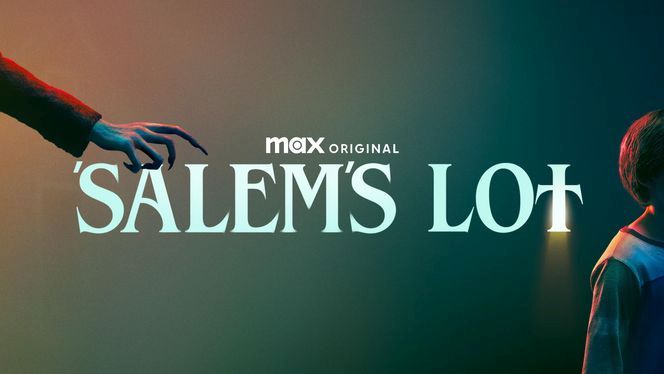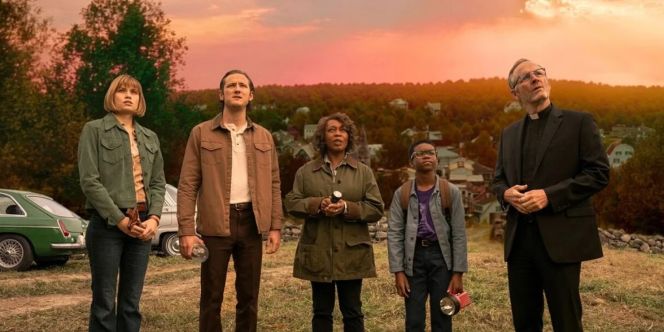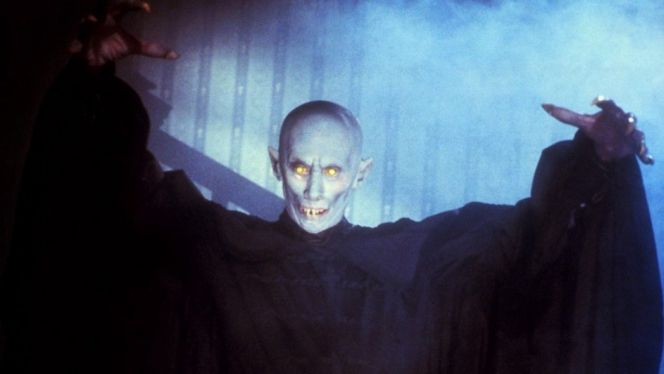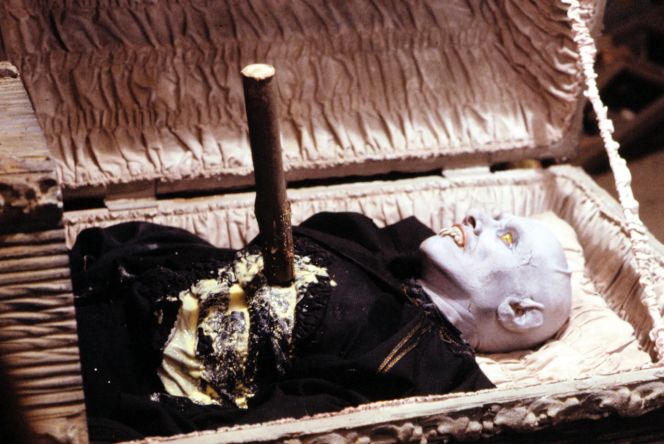MOVIE REVIEW – As a long-time reader of Stephen King’s horror, I’m always fascinated by how the master of the genre incorporates its elements into the stories he chooses to tell. His second novel, Salem’s Lot, published in 1975, utilizes the vampire lore of Bram Stoker’s Dracula to explore the slow decay of small-town America. This theme remains as powerful and relevant today as ever, which makes it all the more disheartening that so much of King’s essence seems to get lost in screen adaptations.
HBO Max’s latest version of Salem’s Lot – following two prior miniseries versions, the first directed by Tobe Hooper of The Texas Chainsaw Massacre fame – does a solid job of conveying what writer Ben Mears (played by Lewis Pullman) experiences when he returns to his hometown of Jerusalem’s Lot, Maine. As soon as Ben arrives to finish his new book, the idyllic small-town vibe instantly calls to mind the settings King’s stories are known for. (Yes, Salem’s Lot was filmed in Massachusetts, but as a native of New Hampshire, I’m used to seeing those two states get lumped together.) In the first five minutes, we’re introduced to William Sadler, a familiar face in King adaptations, donning a town constable’s uniform and taking on Fred Gwynne’s accent from Pet Sematary to warn Ben not to cause trouble on his watch. So far, so good.
When Evil Moves in Next Door
We’re quickly introduced to the town’s colorful residents, including Susan Norton (Makenzie Leigh), a real estate agent in training; Matt Burke (Bill Camp), the schoolteacher; Dr. Cody (Alfre Woodard), the open-minded physician; and Mark Petrie (Jordan Preston Carter), the horror enthusiast. All of them possess that classic small-town wisdom that naturally leads them to band together to face the evil creeping into their lives – nocturnal, bloodthirsty beings that rise from the grave. Though these characters are likable, none of them are given enough depth to make their eventual encounters with death genuinely impactful.
This group is the first to notice the strange occurrences and disappearances that coincide with the arrival of antique dealer Richard Straker (Pilou Asbæk) and his mysterious partner, Barlow. As the disappearances mount, director Gary Dauberman skillfully handles the creeping dread of the novel. One of the film’s most memorable scenes features brothers Ralph and Danny Glick walking home through the woods at dusk. Straker’s sudden appearance and Danny’s abduction deliver a genuine gut punch. And when Ralph believes his missing brother has returned in the dead of night, Dauberman shifts the action from Ralph’s overly lit bedroom to a misty, atmospheric backyard, drawing out the tension to the breaking point. Salem’s Lot is at its best during these moments, where Dauberman conjures a surreal, haunting quality that at times recalls the unsettling creepiness Tobe Hooper smuggled onto primetime television in 1979. However, as the film moves toward a more direct confrontation with the vampires, the style and substance Dauberman achieves in the first act gradually fade away. This pattern plays out in most of the film’s scares – solid buildup followed by uninspired, flat resolutions.
As Ben and his new friends quickly come to grips with the danger threatening their town, Salem’s Lot begins to lose the symbolic power that King infused into his take on vampires. Characters like Matt Burke and Parkins Gillespie (a name only Stephen King could come up with) make passing remarks about how the town was already in decline before Barlow and Straker’s arrival, hinting at broader societal decay. However, these observations fail to resonate because we’re never given enough time to truly understand who these people are or what their relationship to the Lot is. As a result, the townspeople who fall victim to the vampires feel forgettable and interchangeable – a problem that becomes especially apparent as the vampire killings grow increasingly formulaic toward the film’s end.
Vampires, Zombies, and Everything in Between
Salem’s Lot inspired countless other books and films about vampires, but unfortunately, this adaptation feels more like it’s imitating the imitators. The vampires here are portrayed more like mindless zombie soldiers than conscious beings who, while no longer technically alive, are still struggling to balance their thirst for blood with what remains of their humanity. “Generic vampire movie” is not a label I’d want to apply to Salem’s Lot, but by the time Dauberman turns the sinister Barlow into a near-mute CGI-eyed super vampire, it feels fitting. The film frequently relies on glowing eyes and quick cuts of mindless attackers rushing the protagonists. By the time glowing crosses are being wielded like lightsabers, the story feels like it’s lost its way, as if it no longer remembers why it was being told in the first place. This is particularly frustrating given that King’s observations about small-town American life in the 1970s have only grown more relevant in the nearly 50 years since the book’s publication.
Much of the film’s problems stem from an overzealous commitment to the letter – rather than the spirit – of the source material. Salem’s Lot carefully touches on nearly every major scene from the novel and includes as many characters as possible, but there simply isn’t enough time to give everything the depth it deserves. And this comes from Dauberman, who successfully adapted a far more unwieldy King bestseller into the scripts for It: Chapter One and It: Chapter Two. Those adaptations worked largely because of smart changes, like isolating each time period into its own film. Salem’s Lot is a simple story – it’s Dracula in modern-day New England – but even simple stories need time to be told properly, and at times this adaptation feels like it’s in a trance, doing whatever it can to stay under two hours.
The Studio’s Dark Shadow
This brings us to the elephant in the room: Salem’s Lot has been bounced around Warner Bros.’ release calendar for years. That’s not always an indicator of poor quality, but it doesn’t inspire much confidence either, and unfortunately, that proves true here. The frenetic pace the movie adopts as it progresses feels like a product of post-production edits meant to liven things up. The novel’s final confrontation – an intimate, atmospheric scene – is reworked into an overblown action sequence that feels so needlessly showy, it seems like it could only have been the result of a studio note. Some things just don’t need to be tampered with. Dracula provided a solid enough framework for Stephen King back in the 1970s. The creators of Salem’s Lot are sometimes too content to follow the book closely – but cracks begin to show when they stray too far from the original vision.
These Vampires Have Lost Their Soul
Salem’s Lot stands as one of the most frustrating Stephen King adaptations in recent memory. Writer/director Gary Dauberman creates some undeniable atmosphere and assembles a likable group of small-town folks-turned-vampire hunters, and when the film focuses on more intimate moments, it shows real promise. But when the vampires finally take center stage, the movie, much like its undead antagonists, loses its soul.
-Gergely Herpai “BadSector”-
Salem’s Lot
Direction - 4.8
Actors - 5.6
Story - 6.1
Visuals/Horror/Music - 6.2
Ambience - 5.8
5.7
AVERAGE
Like a human being turned into a vampire, Salem’s Lot starts with a strong identity, but slowly loses itself to soulless, mindless vampire clichés.



















Leave a Reply